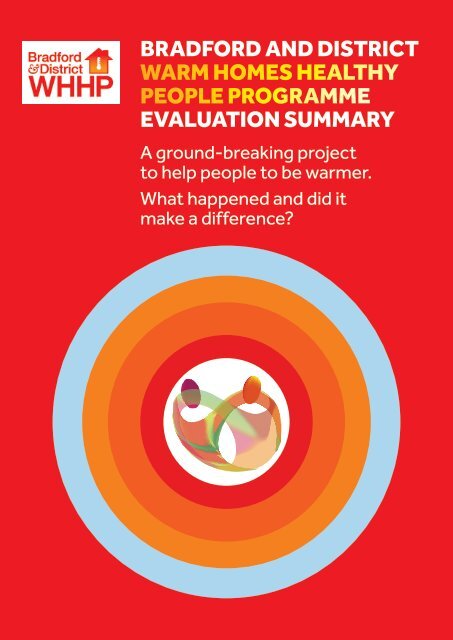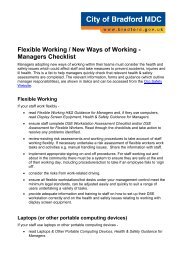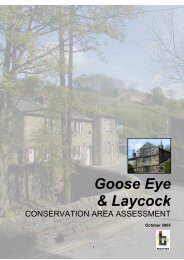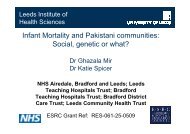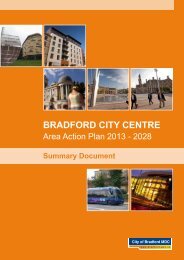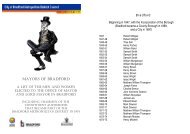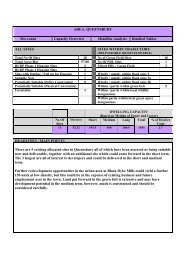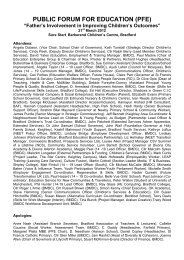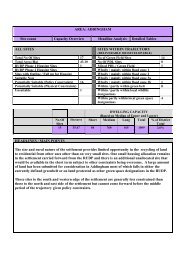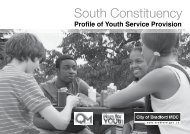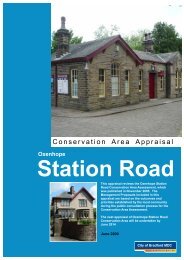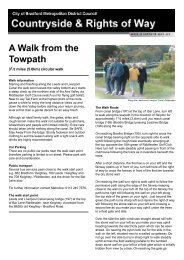Warm Homes Evaluation Summary - Bradford Metropolitan District ...
Warm Homes Evaluation Summary - Bradford Metropolitan District ...
Warm Homes Evaluation Summary - Bradford Metropolitan District ...
Create successful ePaper yourself
Turn your PDF publications into a flip-book with our unique Google optimized e-Paper software.
BRADFORD AND DISTRICT<br />
WARM HOMES HEALTHY<br />
PEOPLE PROGRAMME<br />
EVALUATION SUMMARY<br />
A ground-breaking project<br />
to help people to be warmer.<br />
What happened and did it<br />
make a difference?
BRADFORD AND DISTRICT WARM HOMES HEALTHY PEOPLE PROGRAMME EVALUATION SUMMARY<br />
About the scheme<br />
Between January and April 2012 a ground-breaking initiative took place in the <strong>Bradford</strong><br />
<strong>District</strong>. Funded by £204,500 from the Department of Health through its ‘<strong>Warm</strong> <strong>Homes</strong><br />
Healthy People Fund’, it aimed to help vulnerable people keep warm or to be warmer by:<br />
Giving people cold weather information and advice.<br />
Providing practical support.<br />
Getting neighbours to help each other.<br />
Activities undertaken in this <strong>Warm</strong> <strong>Homes</strong> programme included:<br />
Written information and face-to-face advice on how to keep warm.<br />
Practical help like food parcels, warm clothing, blankets, or heaters.<br />
Hot meals for vulnerable people and children who would not get them otherwise.<br />
Financial help to people who would have not been able to turn on their heating<br />
otherwise.<br />
Provision of household thermometers.<br />
Snow and ice gritting equipment to volunteer groups to help communities deal with<br />
snow problems.<br />
Setting up local street schemes so people help each other when it is cold.<br />
A Summit looking at key messages and next steps.<br />
The activities were delivered by a number of organisations including voluntary and<br />
community organisations, and coordinated by <strong>Bradford</strong> Council’s Department of<br />
Community and Adult Services. All the partners came together in a <strong>Warm</strong> <strong>Homes</strong><br />
Partnership Board.<br />
Evaluating the scheme<br />
“What we did was<br />
only the tip of the<br />
iceberg. I’m sure<br />
we made a big<br />
difference to those<br />
we reached but<br />
only the tip of the<br />
iceberg.”<br />
Evaluators were asked to undertake a review to give an independent assessment of how<br />
the programme worked on the ground. This was done by talking to the organisations<br />
that delivered the activities, as well as beneficiaries and proxy beneficiaries. It is not a<br />
comparative evaluation.<br />
<strong>Evaluation</strong> Conclusion<br />
The main conclusion of this evaluation is that, despite very short timescales, this<br />
has been an extremely successful initiative; providing real, immediate and direct<br />
help to some of the most needy and vulnerable people. No duplication of activity was<br />
identified and potential exists for a larger volume of activity.<br />
The commitment of the organisations and their staff involved has been exceptional.<br />
There is unanimous agreement that there is a need for winter warmth activity in<br />
<strong>Bradford</strong> to continue.<br />
1
BRADFORD AND DISTRICT WARM HOMES HEALTHY PEOPLE PROGRAMME EVALUATION SUMMARY<br />
What activity was undertaken and who benefited?<br />
It is estimated that nearly 50,000 people benefited from this short project through a<br />
variety of services.<br />
Service/activity<br />
Help and advice<br />
A Winter <strong>Warm</strong>th Guide<br />
offering advice to older people<br />
on practical ways to keep warm<br />
in their homes and including<br />
information on health and<br />
safety, fuel and energy<br />
saving tips.<br />
6 Heat or Eat Roadshows gave<br />
advice and support around<br />
eating well, keeping homes<br />
warm and applications to the<br />
national <strong>Warm</strong> Front scheme.<br />
Free resources such as food<br />
bags, light bulbs, duvets and<br />
vouchers were given away.<br />
How many people<br />
benefited<br />
40,000 copies of the winter<br />
warmth guide were printed<br />
and c. 34,000 have been<br />
circulated. The remainder<br />
will be distributed next<br />
winter.<br />
362 people were given<br />
advice and support through<br />
the six road-show events.<br />
Who delivered<br />
this<br />
Age UK <strong>Bradford</strong> &<br />
<strong>District</strong><br />
Carers Resource<br />
Practical help and support to help people be warmer<br />
Small grants to individuals and<br />
families to help with:<br />
Clothing, food and<br />
household items<br />
Fuel bills and arrears<br />
Emergency fuel top-ups<br />
Court fees for debts<br />
Household thermometers.<br />
Clothing, footwear, bedding,<br />
other household items such as<br />
draft excluders, heating items,<br />
cooking facilities etc and food<br />
to help people to be warmer.<br />
At least 207 grants:<br />
82% of applicants were<br />
on a low income<br />
13% were in housing need<br />
9% were older people<br />
49% were disabled people<br />
26% were families<br />
12,000 general household<br />
thermometers were printed<br />
and distributed, with a<br />
further 4,800 available for<br />
distribution next year.<br />
c.849 individuals or families<br />
received support.<br />
The scheme was<br />
run by the Advice<br />
Network & Training<br />
Partnership (ANTP).<br />
Grants were applied<br />
for by member<br />
advice agencies.<br />
Age UK <strong>Bradford</strong> &<br />
<strong>District</strong><br />
ANTP,<br />
HALE (Health Action<br />
Local Engagement<br />
Healthy Living<br />
Project),<br />
HOTS (Health on the<br />
Streets),<br />
In churches through<br />
a number of<br />
churches<br />
2
BRADFORD AND DISTRICT WARM HOMES HEALTHY PEOPLE PROGRAMME EVALUATION SUMMARY<br />
Service/activity<br />
How many people<br />
benefited<br />
Who delivered<br />
this<br />
Food and hot meals through:<br />
Cook and eat sessions<br />
Hot meals<br />
Food parcels<br />
Food vouchers<br />
School dinners<br />
Travel to help people access<br />
the meals<br />
c.9317 hot meals, food<br />
parcels, or vouchers for food<br />
provided.<br />
Services targeted at<br />
individuals, families, families<br />
with children, older people,<br />
children not eligible for free<br />
school meals and homeless<br />
people.<br />
As above plus<br />
<strong>Bradford</strong> Council<br />
Education Service<br />
through individual<br />
schools.<br />
“It was a<br />
phenomenal<br />
amount of work<br />
and also very<br />
different to what<br />
we normally do. It<br />
was bucket loads<br />
of extra work but<br />
we managed it. We<br />
were really glad to<br />
do the project.”<br />
Snow clearing items that can<br />
be used by communities –<br />
including grit spinners, rock salt<br />
and a new gritting trailer.<br />
A Neighbourly Help scheme to<br />
develop street level support<br />
networks for those most<br />
susceptible to accidents or falls<br />
during the winter months.<br />
An estimated minimum of<br />
480 people / families have<br />
been helped by additional<br />
support for community<br />
gritting activities during<br />
snow.<br />
121 streets were targeted<br />
to encourage people to join<br />
the scheme, with 43 people<br />
recruited as either street<br />
coordinators or volunteers.<br />
<strong>Bradford</strong> Council<br />
Highways Dept<br />
Community Gritting<br />
Service<br />
<strong>Bradford</strong> Older<br />
People’s Alliance,<br />
<strong>Bradford</strong> Council’s<br />
Neighbourhood<br />
Service<br />
A central referral system called<br />
First Contact to ensure that<br />
people received all the help<br />
available by delivery partners<br />
and others.<br />
209 individuals/families<br />
had their needs assessed<br />
resulting in 658 referrals.<br />
Age UK <strong>Bradford</strong><br />
coordinated the<br />
scheme with other<br />
agencies dealing<br />
with referrals.<br />
HALE’s mobile outreach<br />
vehicle was used to provide<br />
cook and eat sessions<br />
3
BRADFORD AND DISTRICT WARM HOMES HEALTHY PEOPLE PROGRAMME EVALUATION SUMMARY<br />
Strategic Summit<br />
A strategic multi agency Summit was held on 24th May 2012 to learn lessons from the<br />
programme, identify gaps and coordinate agencies to ensure a joined-up approach for<br />
future winters.<br />
51 people from a range of agencies attended. The main messages matched the findings<br />
of the evaluation and participants were keen to look at how they can use the experience<br />
of the programme/evaluation findings to continue to address needs related to winter<br />
warmth.<br />
How was the money spent?<br />
Neighbourly help scheme £27,570<br />
Advice & information £18,64<br />
Practical support £137,550<br />
Summit £2,500<br />
Project management & evaluation £18,260<br />
What did the evaluation find?<br />
That this was a highly successful initiative and should be continued.<br />
The programme was able to respond to individual needs, building on what already<br />
exists.<br />
The partnership arrangements formed a coherent programme, despite a diversity<br />
of activities and organisations involved, many of whom had not worked together<br />
previously.<br />
Agencies wanted to be involved because of a very real commitment to the aims and<br />
because they appreciated being involved in a programme with such real, tangible<br />
results. It was described as a morale booster and with a high feel good factor for<br />
those involved.<br />
Not all organisations asked for management fees and costs were kept to a minimum.<br />
People undertook the work in addition to their ‘day jobs’.<br />
Despite the positive findings, there were a number of challenges.<br />
4
BRADFORD AND DISTRICT WARM HOMES HEALTHY PEOPLE PROGRAMME EVALUATION SUMMARY<br />
Key messages emerged in themes<br />
A number of themes emerged during the evaluation which provide details of what<br />
worked well as well as noting some of the challenges and lessons.<br />
1<br />
Theme 1 – Winter warmth or poverty?<br />
Respondents were shocked by the level of need.<br />
Whilst fuel poverty and poverty is different, in many of the areas of <strong>Bradford</strong><br />
where the programme was operating, they are inextricably linked.<br />
“It’s been a real eye opener. We started off looking at winter warmth and<br />
found out a lot about poverty.”<br />
“There’s been an increase in demand in our services due to the nature of the<br />
economy. People are struggling to manage, to cope with the demand due to<br />
the volume of people. Lots of funding streams have been cut. It’s horrifying to<br />
see what people are living with.”<br />
2<br />
Theme 2 – Collaborative advantage<br />
Partnership working was extremely effective and the collaborative advantage<br />
high.<br />
There was good communication, with potential to improve.<br />
There was considerable trust and respect between partners, and for and by<br />
the Council.<br />
There was no competition for budgets or jostling for underspends.<br />
The Partnership Board, sub groups, general partnership working<br />
arrangements worked well overall.<br />
New partnerships and relationships have been developed which have already<br />
led to new joint service delivery and may continue to do so.<br />
A number of challenges were highlighted:<br />
At times too much communication (emails, meetings etc) with a lack of clarity<br />
about what was important.<br />
One element of the work ‘fell through the net’ between agencies.<br />
Not all agencies and departments within agencies were as engaged as would<br />
have been helpful.<br />
“There’s been a war-time spirit, everyone pulling together to get something<br />
achieved.”<br />
5<br />
“One thing <strong>Bradford</strong> is good at is joint-working and partnership working. At<br />
the end of the day it’s a person we’re helping. There’s been a massive benefit<br />
to working relationships.”
BRADFORD AND DISTRICT WARM HOMES HEALTHY PEOPLE PROGRAMME EVALUATION SUMMARY<br />
3<br />
Theme 3 – Response to need and<br />
an individuality of approach<br />
Central to the success of the programme was the ability to respond to<br />
individual people and family’s needs - the approach was bottom up not top<br />
down.<br />
The programme built well on existing knowledge of the partners about need,<br />
and on existing relationships with clients and other partners.<br />
Partners were allowed to think creatively to provide solutions to individual<br />
needs.<br />
Services were delivered where people live or by agencies they already<br />
accessed.<br />
“Because we had done the older people’s work we knew what was needed<br />
for older people.”<br />
“[One] Children’s Centre said they had a family who weren’t accessing<br />
services because mum did not have a buggy to enable them to get out to the<br />
services. So we got them a buggy and gave it to the family and now they<br />
get out. The family don’t know where it came from but they can get out and<br />
about. It was bought from a local small supplier who wrote a letter saying<br />
how grateful they had been used rather than a large retailer.”<br />
4<br />
Theme 4 – Building on existing strengths<br />
All activity built on existing knowledge and relationships. There was no<br />
attempt to re-invent the wheel. As a result delivery happened very quickly.<br />
Existing knowledge was used to identify need and the most appropriate ways<br />
to meet it – including other organisations and networks where relationships<br />
already existed.<br />
Where delivery partners were unsure they were able to check things with the<br />
other organisations they already worked with.<br />
Many activities were tagged onto existing services which helped speed and<br />
quality of activity.<br />
Even new activities built on what already existed. Potential new avenues have<br />
been created for some organisations.<br />
“It was very different to what we normally do but it needed our [current]<br />
scheme to build on or it couldn’t have happened.”<br />
“We always knew there was a need but we didn’t have the money for<br />
resources. Knowing the need and having the existing partnerships and<br />
connections is why we could just do it like that.“<br />
6
BRADFORD AND DISTRICT WARM HOMES HEALTHY PEOPLE PROGRAMME EVALUATION SUMMARY<br />
5<br />
Theme 5 – Flexibility, trust and goodwill<br />
There was total commitment by partners to make the programme and<br />
partnership work.<br />
Goodwill from individuals, and between partners impacted on every aspect of<br />
this programme.<br />
Partners felt that the Council worked well, worked flexibly, with a real respect<br />
for them and trust in what they were doing.<br />
Processes used were designed to be as flexible as possible, whilst meeting the<br />
Department of Health criteria. The Council managed the programme well.<br />
The absence of unnecessary bureaucracy was welcomed by all.<br />
Partners felt this allowed them to get on and provide the best and most<br />
responsive service.<br />
“I found that the team at the Council were excellent. It was very, very clear<br />
and yet they allowed the autonomy to work out what we would do. We could<br />
make our own professional judgement.”<br />
A number of challenges were highlighted however:<br />
There were no common systems for finance or outputs. As a result it is<br />
not possible to give fully accurate simple figures for total services in the<br />
evaluation report.<br />
Some partners felt that they would have appreciated more guidance on<br />
expectations, attending meetings, what data to collect and monitoring to<br />
undertake, finance, and spend processes.<br />
6<br />
Theme 6 – Effect of timescales<br />
All respondents said the speed had been too fast and they would have liked<br />
more time to plan.<br />
There were occasions when existing bureaucracy within agencies got in the<br />
way.<br />
As a result, at times they felt it was a ‘leap of faith’ as to whether their plans<br />
would work.<br />
However the evaluation found that the speed may have had a beneficial impact on<br />
the programme and helped the programme work well:<br />
The speed resulted in the lack of unnecessary bureaucracy.<br />
There was a focus on action not process; people just got on with doing the job<br />
and delivering to vulnerable and needy people.<br />
7<br />
“The partnership working was good, all set up really quickly. Sometimes you<br />
can over-plan stuff. Working relationships in the area are really good and in<br />
reality it all worked out in the end. I’d rather have that than have 6 months of<br />
planning.”
BRADFORD AND DISTRICT WARM HOMES HEALTHY PEOPLE PROGRAMME EVALUATION SUMMARY<br />
7<br />
Theme 7 – Community engagement<br />
A Neighbourly Help scheme gave a potential long term legacy from the<br />
programme.<br />
Two different models were tried out – using Council Wardens and using<br />
voluntary sector Community Development Workers<br />
A number of street coordinators and volunteers have been recruited.<br />
It was easier to recruit in some areas than others.<br />
Feedback from the projected has suggested:<br />
Generally there was good feedback about the idea behind the scheme, but<br />
many people didn’t feel a formal scheme is needed as they do this kind of thing<br />
anyway.<br />
Council involvement made some people suspicious and created barriers; for<br />
others gave the scheme a legitimacy.<br />
Questions arose around liability and CRB checks.<br />
It’s too early to know whether this scheme has worked and more development<br />
is needed.<br />
“Hopefully, [it will generate] a greater sense of community. Neighbours that<br />
say morning to each other, or do more than that. If it gets people talking to<br />
each other even if they’re not doing anything, they have had that ice-breaking<br />
to get to know your neighbours, it makes you more inclined to go<br />
to somebody when you need.”<br />
8<br />
Theme 8 – Signposting and referral<br />
• The programme included a central referral system – First Contact. It was a<br />
good decision to include a referral system.<br />
• A central referral system could have been a place to keep programme data as<br />
well as ensuring vulnerable people got all the help available to them.<br />
However, there were too many challenges in this programme for First Contact to<br />
achieve its potential due to the short timescales:<br />
• There was insufficient time to undertake the practical development and<br />
testing needed of the database.<br />
• There was insufficient time to get full buy-in from all the partners and for all<br />
partners to undertake the necessary training.<br />
“It was helpful. You weren’t leaving people in limbo and were able<br />
to help people.”<br />
8
BRADFORD AND DISTRICT WARM HOMES HEALTHY PEOPLE PROGRAMME EVALUATION SUMMARY<br />
9<br />
Theme 9 – Strategic fit and strategic links<br />
As well as the Cold Weather Plan for England, this programme fits with<br />
The Community Strategy and with a number of other <strong>Bradford</strong> strategies.<br />
However, although fuel poverty is mentioned, the needs addressed by this<br />
programme are arguably addressed implicitly rather than explicitly:<br />
The needs covered by this programme are even more basic than those<br />
covered by the strategies.<br />
As a result, there is a danger that these needs may not be explicitly addressed<br />
in future strategies and action plans.<br />
There is a need to ensure the <strong>Warm</strong> <strong>Homes</strong> Partnership Board fits within<br />
the overall strategic partnership structure in <strong>Bradford</strong>.<br />
9
BRADFORD AND DISTRICT WARM HOMES HEALTHY PEOPLE PROGRAMME EVALUATION SUMMARY<br />
Worked well and could do better<br />
The evaluation found many positives as well as identifying a number of challenges or<br />
areas that could be improved in future.<br />
What worked well?<br />
The activities met the aims of the bid and targeted services to needy and vulnerable<br />
people by providing very real, practical and immediate help.<br />
Activity responded creatively to individual need in people’s local areas.<br />
Activity built on existing services, knowledge and networks.<br />
Good choice of partners and delivery organisations.<br />
Fast timescales meant emphasis on delivery, not process.<br />
Goodwill, trust and respect between all the partners and good practice partnership<br />
working.<br />
Generated a real feel-good factor and morale boost for those involved.<br />
Programme management arrangements allowed a very flexible approach and little<br />
bureaucracy.<br />
The Partnership board and sub group arrangements were effective.<br />
New partnerships have been developed leading to new services.<br />
There is a potential longer term legacy through encouraging people to be helpful<br />
neighbours.<br />
What could have been better?<br />
More time for planning would have helped.<br />
Agencies had to set up individual purchasing and distribution systems.<br />
Communication could have been clearer and more streamlined.<br />
More agencies and departments could have been involved.<br />
Systems to ensure no work ‘fell through the net’ between agencies.<br />
Common systems for monitoring and data collection.<br />
Guidance on expectations of partner agencies.<br />
The referral system needed more time.<br />
Almost all partners delivered in addition to ongoing work, either through working extra<br />
hours or by putting other work on hold. This was possible for a time-limited project but<br />
is not sustainable.<br />
10
BRADFORD AND DISTRICT WARM HOMES HEALTHY PEOPLE PROGRAMME EVALUATION SUMMARY<br />
What some of the people & organisations helped said<br />
“It’s been an absolute blessing.”<br />
“It’s been really good at reducing isolation.”<br />
“The general feedback was that the women were very grateful.”<br />
“It was incredibly helpful.”<br />
“I like the fact that the team addressed food poverty not just fuel poverty.”<br />
“The best thing is it’s guaranteeing that our children are fed.<br />
We couldn’t guarantee that before.”<br />
“It was really helpful. If she’s giving you something it’s going to be good.<br />
I never asked for anything, just got it.”<br />
“It was all fantastic. The fact that it allowed us to re-engage with families.<br />
It did wonders for our PR.”<br />
SureStart HBT<br />
11
BRADFORD AND DISTRICT WARM HOMES HEALTHY PEOPLE PROGRAMME EVALUATION SUMMARY<br />
Real stories of people helped<br />
Mr B is new to the area, having recently moved from another part of the country<br />
and is reliant on the support of his neighbour to read and day-to-day living. He<br />
suffers from bronchitis and poor vision, and is illiterate, unable to read or write<br />
or call agencies to get help.<br />
His living conditions at the point of contact were very poor. He relied on his<br />
neighbour to help collect welfare benefits and was living in a one-bedroom flat<br />
where there was just one mattress and portable TV with no other appliances<br />
or furniture. Mr B was delivered an emergency food parcel, a thermometer and<br />
several clothing items including thermal underwear, gloves, hat, scarf<br />
and socks.<br />
On delivering the items, Mr B commented, “I am so grateful for all of these<br />
things. It does get very cold in this flat.”<br />
A 56 year old Asian woman was in fuel arrears, struggling to heat her home or eat<br />
an adequate diet. She also lacked warm clothes. The money awarded allowed her<br />
to buy clothes, blankets and heaters. She also collected food parcels provided<br />
by the food bank. She is now working towards managing her money and talking<br />
with the fuel companies to arrange a payment plan.<br />
A 46 year old female who has scoliosis of the spine, a duodenal ulcer, asthma and<br />
a low blood count has a 6 year old daughter who helps to care for her. Money is<br />
an issue for mum and she only puts the heating on when her daughter is in the<br />
house and switches it off when her daughter goes to bed. The scheme allowed<br />
her to pay her fuel bills, to buy her daughter a new coat and to buy blankets<br />
and bedding.<br />
One asylum seeker started to cry when he was given a pair of gloves. He couldn’t<br />
buy gloves with his vouchers and he was just so cold. Another asylum seeker was<br />
given a food parcel. She opened the Weetabix in the parcel and started eating it<br />
straight away.<br />
12
BRADFORD AND DISTRICT WARM HOMES HEALTHY PEOPLE PROGRAMME EVALUATION SUMMARY<br />
A 47 year old Asian male with a wife and 6 children who has severe mental health<br />
problems and asthma. The boiler broke and could not be mended. The national<br />
<strong>Warm</strong> Front scheme was contacted to furnish a new boiler but they were not<br />
able to fund this. The bedrooms were cold and so the whole family would gather<br />
round one gas fire downstairs. This was a distraction for the older children who<br />
had university work to do. The scheme bought them heaters for their bedrooms,<br />
curtains, draft excluders and warm clothes.<br />
Through joint working with a Drugs Service, one client in very difficult<br />
circumstances – no money, no food, no electricity or gas (on prepayment meter)<br />
was identified. The client was given small amount of cash to top up his meter and<br />
vouchers for supermarket. He cried, saying he couldn’t believe that someone<br />
would be willing to help in this way.<br />
One dad specifically requested wellies for himself so that he could take his<br />
children out in the bad weather. He planned to take them to the local woods<br />
as they do not have enough money for trips to town. This is very important<br />
for this particular family as mum has mental health issues and is agoraphobic<br />
and is rarely able to get out with the children. The family reported improved<br />
relationships.<br />
A woman had received a quilt, wellies, pillows, and a fleecy blanket from the<br />
scheme. She had arthritis, was in a lot of pain and needed to keep warm. Then<br />
a few days later she asked for an electric blanket. She rang the agency to tell<br />
them how the electric blanket has changed her life. She was nearly crying on the<br />
phone saying how the agency worker is her angel and like a butterfly.<br />
13
BRADFORD AND DISTRICT WARM HOMES HEALTHY PEOPLE PROGRAMME EVALUATION SUMMARY<br />
What next? The evaluation<br />
recommendations for the future<br />
“Its re-enforced how<br />
much need there is.<br />
The stories are not<br />
unusual and it will<br />
be hard next winter<br />
if there are no more<br />
resources knowing<br />
the need is there.<br />
We’ve opened a can<br />
and will be sad if<br />
between us all we<br />
can’t come up with<br />
something knowing<br />
what difference it’s<br />
made.”<br />
“Even if the funding<br />
is one-off at least<br />
it has highlighted<br />
what is needed and<br />
we could look at<br />
how we could be<br />
more creative in<br />
how to get it, this<br />
could be something<br />
that we could<br />
maximise. The need<br />
is there, unearthed<br />
the fact that people<br />
are hungry. Now<br />
we’ve identified it<br />
we need to think<br />
where we take it,<br />
what we do about<br />
it, what we can<br />
collectively do<br />
about it.”<br />
Findings from the evaluation are that all efforts should be made to continue similar<br />
activity, though the report makes a number of recommendations for changes:<br />
If the programme continues, it is important that it is fully funded.<br />
It should continue to be provided by range of partners.<br />
The question of whether services should be more targeted at specific groups or<br />
areas should be considered.<br />
A potential private sector sponsor should be sought.<br />
All public sector commissioners, including the NHS, should look at potential future<br />
funding.<br />
A future project needs to retain the flexibility, trust and lack of bureaucracy of this<br />
programme. However standard monitoring systems are needed.<br />
A central referral process needs to be included.<br />
A central purchase/distribution system should be set up.<br />
All organisations should look at what they do in the light of this project.<br />
Further work is needed to assess the Neighbourly Help scheme.<br />
In addition, the evaluation recommends:<br />
All relevant organisations should look at their activities in the light of this<br />
programme.<br />
If no funding is available, the Partnership Board should still consider how to still<br />
address winter warmth basic needs.<br />
The Partnership Board ensures that <strong>Bradford</strong> strategies, including The Community<br />
Strategy and NHS plans address the basic needs covered by this initiative.<br />
The lessons from this programme are considered when looking at future<br />
arrangements for the Social Fund and Health Promotion responsibilities which are<br />
due to transfer to the Council.<br />
ANTP should consider running an on-going grant programme.<br />
Items purchased,<br />
SureStart HBT<br />
14
BRADFORD AND DISTRICT WARM HOMES HEALTHY PEOPLE PROGRAMME EVALUATION SUMMARY<br />
For more information or a copy of the full evaluation report contact Tina Butler or<br />
Becky Allright at CommissioningInbox@bradford.gov.uk<br />
This summary was produced by Peg Alexander and Judith Foster, independent<br />
consultants. www.pegalexander.com and judith.foster117@ntlworld.com.<br />
It was produced on behalf of the <strong>Warm</strong> <strong>Homes</strong> Healthy People Partnership Partners.<br />
Some partners were involved in advice and guidance to the partnership as a whole<br />
through regular meetings, whereas others were responsible for direct delivery or<br />
assistance to the delivery partners.<br />
The partners were: Advice Network and Training Partnership, Age UK <strong>Bradford</strong><br />
and <strong>District</strong>, Alzheimer’s Society, <strong>Bradford</strong> CAB – Energy & Advice Partnership,<br />
<strong>Bradford</strong> MDC: Adult & Community Services, <strong>Bradford</strong> MDC: Children’s Services,<br />
<strong>Bradford</strong> MDC: Neighbourhood Services, <strong>Bradford</strong> MDC: Regeneration & Culture,<br />
<strong>Bradford</strong> Older People’s Alliance, <strong>Bradford</strong> Volunteering Strategic Partnership,<br />
Carers Partnership, Carers’ Resource, Family Action (Canterbury Advice Centre),<br />
HALE, HOTS, Incommunities (Assisted in delivery of the winter warmth guides),<br />
Innchurches, Joseph Rowntree Foundation, Learning Disability Partnership, Meri<br />
Yaadain Dementia Team, Older People’s Strategic Partnership, Positive Minds, Public<br />
Health (Every Baby Matters), Public Health (NHS Airedale, <strong>Bradford</strong> & Leeds) , Senior<br />
Show the Way (<strong>Bradford</strong> <strong>District</strong> Care Trust), Strategic Disability Partnership, West<br />
Yorkshire Fire Service (Collected and delivered Winter warmth guide to stations).<br />
City of <strong>Bradford</strong> MDC<br />
www.bradford.gov.uk<br />
<strong>Bradford</strong> <strong>District</strong><br />
Care Trust


